Nuclear Fission Explained: All You Need to Know
Impactful Ninja is reader-supported. When you buy through links on our site, we may earn an affiliate commission.
Learn more
Learn more
.
Hey fellow impactful ninja ? You may have noticed that Impactful Ninja is all about providing helpful information to make a positive impact on the world and society. And that we love to link back to where we found all the information for each of our posts. Most of these links are informational-based for you to check out their primary sources with one click. But some of these links are so-called "affiliate links" to products that we recommend. First and foremost, because we believe that they add value to you. For example, when we wrote a post about the environmental impact of long showers, we came across an EPA recommendation to use WaterSense showerheads. So we linked to where you can find them. Or, for many of our posts, we also link to our favorite books on that topic so that you can get a much more holistic overview than one single blog post could provide. And when there is an affiliate program for these products, we sign up for it. For example, as Amazon Associates, we earn from qualifying purchases. First, and most importantly, we still only recommend products that we believe add value for you. When you buy something through one of our affiliate links, we may earn a small commission - but at no additional costs to you. And when you buy something through a link that is not an affiliate link, we won’t receive any commission but we’ll still be happy to have helped you. When we find products that we believe add value to you and the seller has an affiliate program, we sign up for it. When you buy something through one of our affiliate links, we may earn a small commission (at no extra costs to you). And at this point in time, all money is reinvested in sharing the most helpful content with you. This includes all operating costs for running this site and the content creation itself. You may have noticed by the way Impactful Ninja is operated that money is not the driving factor behind it. It is a passion project of mine and I love to share helpful information with you to make a positive impact on the world and society. However, it's a project in that I invest a lot of time and also quite some money. Eventually, my dream is to one day turn this passion project into my full-time job and provide even more helpful information. But that's still a long time to go. Stay impactful,Affiliate Disclosure
Why do we add these product links?
What do these affiliate links mean for you?
What do these affiliate links mean for us?
What does this mean for me personally?
![]()
Nuclear fission involves splitting apart the nucleus of an atom to release enormous amounts of energy in the form of heat and radiation. It has evolved into our second-largest source of low-carbon energy today despite facing negative public opinion. So, we had to ask: What is nuclear fission really, and how can it help mitigate climate change?
Nuclear fission is the generation of energy produced when splitting apart the nucleus of an atom. Per kWh of energy produced, nuclear fission emits 12 grams of carbon dioxide (CO2) on a life-cycle basis. It combats climate change but faces negative opinions due to nuclear waste byproducts.
Keep reading to find out all about what nuclear fission is, its global capacity, its carbon footprint, its environmental benefits and drawbacks, and how it can mitigate climate change.
The Big Picture of Nuclear Fission
Nuclear fission contributes to the avoidance of greenhouse gas (GHG) emissions from the burning of fossil fuels (e.g., coal, oil, natural gas). It is classified as a nonrenewable energy source because Uranium-235, the ingredient for nuclear fission, is a finite resource found in a concentration of 2.8 parts per million (0.7% abundance) in the Earth’s crust.
How Is Nuclear Fission Defined
Nuclear fission, one of two ways to produce nuclear energy, is the generation of energy produced when splitting apart the nucleus of an atom.
“Nuclear fission: a nuclear reaction in which a heavy nucleus splits spontaneously or on impact with another particle, with the release of energy.”
Cambridge Dictionary
All operating nuclear power plants today utilize the process of nuclear fission. Because of this, nuclear fission is commonly referred to as ‘nuclear energy’ in the data and literature.
| What nuclear fission is | Nuclear fission is the process by which neutrons are used to split the nucleus of an atom, which releases an enormous amount of energy in the form of heat and radiation. |
| How nuclear fission works | When a neutron strikes the nucleus of an atom, the atomic center can break apart into pieces, thereby releasing energy in the form of radiation and heat. The heat then turns turbines and powers generators to create electricity. |
| The global capacity of nuclear fission | Nuclear energy accounted for roughly 10% of global electricity generation in 2022, generating approximately 2,500 terawatt hours (TWh) of electricity from approximately 413 gigawatts (GW) of installed capacity. The US, China, France, Russia, Republic of Korea together represent roughly 70% of the world’s nuclear energy generation. |
| The carbon footprint of nuclear fission | On a life-cycle basis, nuclear power (nuclear fission) emits 12 grams of CO2 equivalent per kilowatt-hour (KWh) of electricity produced, which is tied for the third-lowest out of all energy types. |
| The environmental benefits of nuclear fission | Nuclear fission has a low carbon footprint, has a minimal land use impact, is energy dense, generates very little waste, promotes energy security and energy independence, and creates jobs. |
| The environmental drawbacks of nuclear fission | The main environmental drawbacks associated with nuclear fission are uranium mining and nuclear waste, which can be mitigated if handled properly. |
| Nuclear fission and climate change | Nuclear fission combats climate change by mitigating the temperature rise, sea-level rise, ice melting, and ocean acidification associated with global warming. |
How Does Nuclear Fission Work
Nuclear fission is the process by which neutrons are used to split the nucleus of an atom, which releases an enormous amount of energy in the form of heat and radiation.
How Does Nuclear Fission Actually Produce Energy
When it comes to nuclear fission, we need to start with atoms. All matter consists of atoms, each of which contains a nucleus. When a neutron strikes the nucleus of an atom, the atomic center can break apart into pieces, thereby releasing energy in the form of radiation and heat.
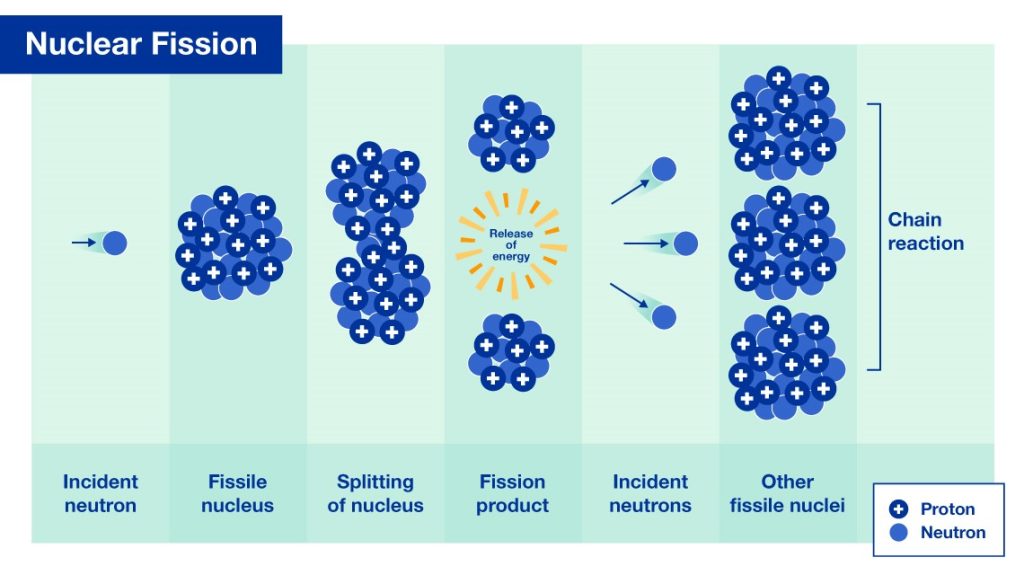
All nuclear fission power plants operate in the following manner:
- The reactor starts and U-235 atoms in the reactor core split (fission), releasing heat and neutrons.
- Neutrons fission other nuclei in the reactor core in a chain reaction, generating more heat and more neutrons.
- Control rods contain materials that absorb some of the neutrons, helping to contain the chain reaction.
- The heat generated turns water that surrounds the immersed reactor into steam.
- The steam spins a turbine which drives a generator to produce electricity.
What Is the Global Capacity of Nuclear Fission
Nuclear energy accounted for roughly 10% of global electricity generation in 2022, generating approximately 2,500 TWh of electricity from approximately 413 GW of installed capacity.
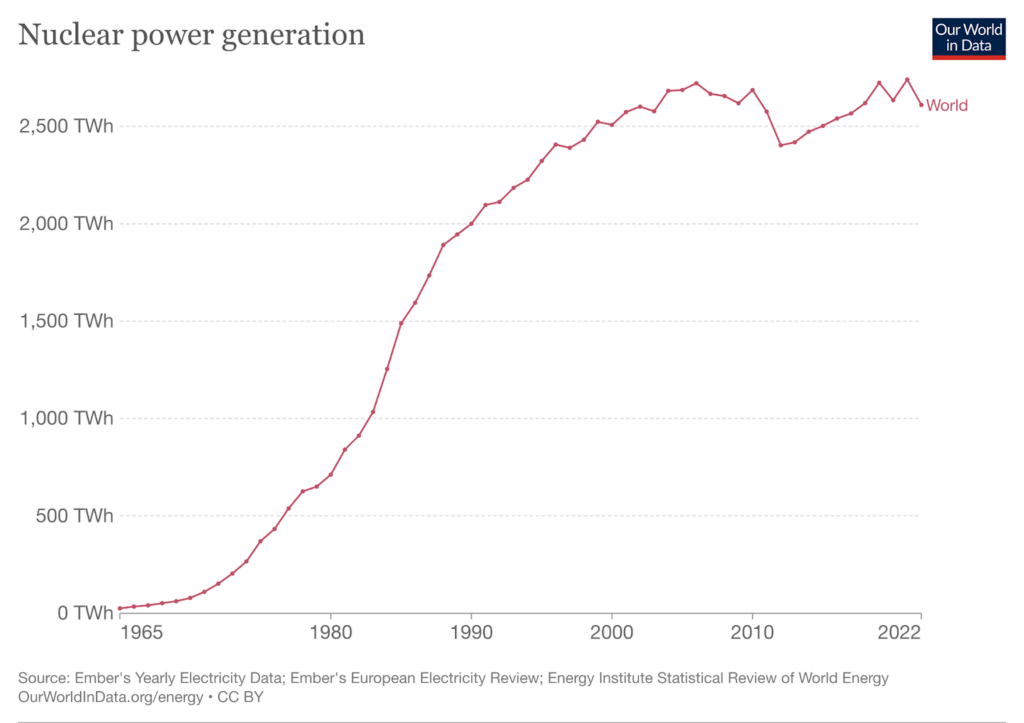
Historically, the US has led the way in nuclear energy, with 93 operating commercial nuclear reactors at 54 nuclear power plants. But more recently, China has emerged as a global leader in nuclear energy. China currently has 21 nuclear reactors under construction, two and a half times more than any other country, which will contribute an additional 21 GW of electricity.
Some countries rely heavily on nuclear energy whilst others have not yet tapped into the resource. For example, nuclear energy provides roughly 60% of France, Slovakia, and Ukraine’s electricity, but South America and Africa get virtually no energy from nuclear. The top 5 countries (The US, China, France, Russia, Republic of Korea) represent roughly 70% of the world’s nuclear energy generation.
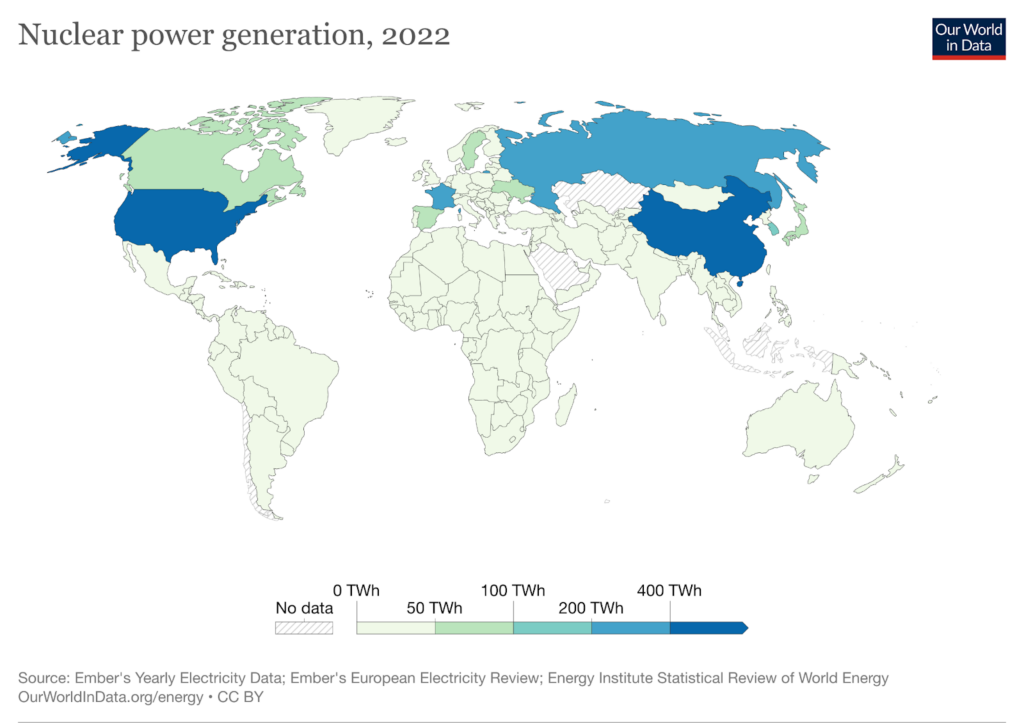
The future of nuclear fission remains uncertain. Although it can produce relatively emissions-free energy and adjust its energy output to compensate for shifts in renewable energy output, nuclear fission also faces high upfront costs and negative public opinion.
Overall, the IEA has labeled nuclear energy as ‘more efforts needed’ in their Net Zero by 2050 Scenario, a framework for the global energy sector to achieve net zero CO2 emissions by 2050 and universal energy access by 2030.
In terms of capacity additions, nuclear energy capacity must increase from 414 GW to 545 GW by 2030 to stay on track in the net zero scenario. Currently, there are about 60 nuclear reactors under construction in 15 countries, most notably in China, India, and Russia.
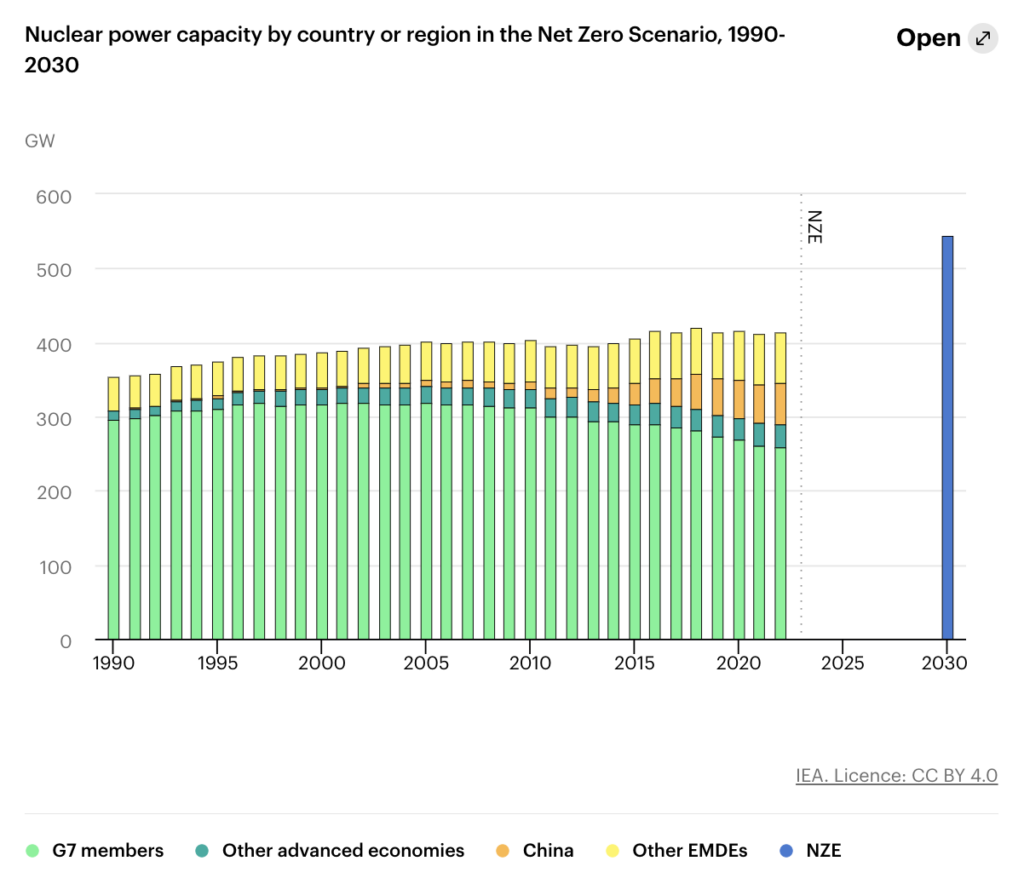
In terms of funding, nuclear investment must triple to $125 billion per year to stay on track in the net zero scenario. Investment averaged only $40 billion per year from 2016-2022, but the Intergovernmental Panel on Climate Change (IPCC) predicts global investments to increase to over $100 billion per year through 2050.
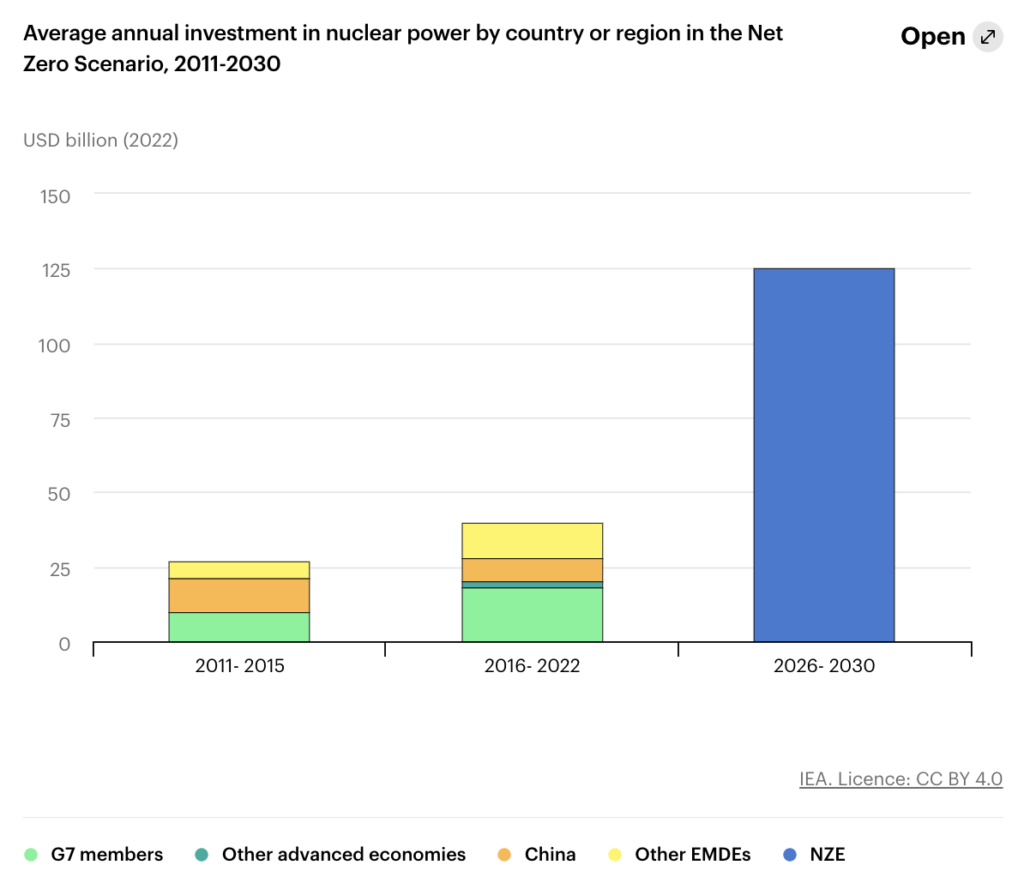
Going forward, nuclear energy will continue to be an important part of our energy mix. Nuclear energy helps avoid 1.5 gigatons of emissions per year and 180 billion cubic meters of global gas demand per year. In the past 50 years, nuclear energy has helped avoid over 70 gigatons of emissions.
What Is the Carbon Footprint of Nuclear Fission
The carbon footprint is one of the ways we measure the effects of human-induced global climate change. It primarily focuses on the greenhouse gas (GHG) emissions associated with consumption and includes other emissions such as methane (CH4), nitrous oxide, and chlorofluorocarbons (CFCs).
“Carbon footprint: the amount of greenhouse gasses and specifically carbon dioxide emitted by something (such as a person’s activities or a product’s manufacture and transport) during a given period”
Merriam Webster
Basically, it is the amount of carbon emitted by an activity or an organization. This includes GHG emissions from fuel that we burn directly (e.g., heating a home or driving a car) and GHG emissions from manufacturing the products that we use (e.g., power plants, factories, and landfills).
On a life-cycle basis, nuclear power (nuclear fission) emits 12 grams of CO2 equivalent per kilowatt-hour (kWh) of electricity produced, which is tied for the third-lowest out of all energy types.
Have a look at the illustration below to see the average life-cycle CO2 equivalent emissions of different energy sources and how they compare to nuclear.

When discussing the carbon footprint of nuclear fission, we must take into account carbon emissions across the energy’s building, operating, and building back phases.
| The life-cycle stages of nuclear fission | Each stage’s carbon footprint |
| Building of nuclear fission | Some CO2 emissions from constructing the nuclear power plant, mining and processing uranium, and transporting nuclear fuel to the power plant |
| Operating of nuclear fission | Little to no CO2 emissions or waste products |
| Building back of nuclear fission | Some CO2 emissions from transporting used fuel/radioactive material and deconstructing the power plant |
Nuclear power makes up 10% of our global electricity generation. Because it is often described as an efficient, safe, and clean energy substitute for fossil fuels, understanding nuclear fission’s carbon footprint and how its carbon emissions affect the global climate change process is important.
How Environmentally Friendly Is Nuclear Fission
The overall environmental friendliness of nuclear fission is a controversial topic. Although the process of nuclear fission produces zero CO2 emissions, the handling and disposal of nuclear waste is a serious issue.
“Environmentally friendly: (of products) not harming the environment.”
Cambridge Dictionary
Nuclear fission can reduce the effects of global warming by limiting global emissions, but uranium mining and nuclear waste are drawbacks that must be taken into consideration.
What Are the Environmental Benefits of Nuclear Fission
Nuclear fission is expected to continue to play a key role in the clean energy movement. This is because nuclear:
- Has a low carbon footprint: Nuclear energy has an average life-cycle CO2 equivalent emission value that is much less than coal, 12g of CO2 equivalent per kWh compared to 820g of CO2 equivalent per kWh, respectively.
- Has a minimal land use impact: Nuclear power produces more electricity on less land than any other clean-air source. A standard, 1,000-megawatt facility requires only a little more than 1 square mile to operate, a number that is 360 and 75 times less than what is required for wind farms and solar power plants, respectively.
- Is energy dense: Nuclear fuel is extremely dense, so you don’t need a lot of it to create a lot of energy. One U-235 pellet 1 inch tall is the equivalent of 1 ton of coal. Since 1 ton of coal creates 2.086 tons (4,172 lbs) of CO2 when it is burned, a 1-inch U-235 pellet directly avoids the emission of over 2 tons of CO2 from our atmosphere.
- Generates very little waste: A typical 1,000-megawatt nuclear fission facility produces only three cubic meters of nuclear waste. In comparison, the average coal-fired power plant produces roughly 300,000 tons of coal ash and more than 6 million tons of CO2 every year.
- Promotes energy security: Nuclear energy contributes to energy security by increasing the stability of our power grids. Unlike renewable energy, which faces variations in supply and demand, nuclear energy can provide a reliable and consistent source of clean energy.
- Promotes energy independence: Being able to produce your own electricity without the aid of foreign countries is an important step in becoming self-sufficient. For example, former President George W. Bush signed the Energy Independence and Security Act of 2007 to reduce US dependence on oil, expand the production of renewable fuels (and confront global climate change).
- Creates jobs: In the US alone, the nuclear industry employs 100,000 people directly and 475,000 jobs secondarily. Because there are 60 reactors under construction currently and 110 more are being planned, the number of jobs is expected to continue to increase globally.
What Are the Environmental Drawbacks of Nuclear Fission
Nuclear fission does come with some drawbacks that, if handled properly, can be mitigated. The main environmental drawbacks associated with nuclear fission are uranium mining and nuclear waste.
- Uranium mining: This process contaminates the environment with radioactive dust, radon gas, water-borne toxins, and increased levels of background radiation. Exploratory drilling and mining also heavily increase the risk of water contamination.
- Nuclear waste: Although nuclear power produces minimal waste, the waste that it does produce is radioactive and can remain hazardous for many thousands of years. These radioactive waste products include uranium mill tailings, spent (used) reactor fuel, and other radioactive wastes. If these were to leach into the environment it could contaminate the soil and water.
Ways to minimize negative environmental impacts include the proper handling, transportation, storage, and disposal of radioactive waste to ensure that it does not leach into the environment.
Why Is Nuclear Fission Important to Fight Climate Change
Climate change is arguably the most severe, long-term, global impact of fossil fuel combustion. Every year, approximately 33 billion tons (bt) of CO2 are emitted from burning fossil fuels. The carbon found in fossil fuels reacts with oxygen in the air to produce CO2. This warms the earth by acting as a heating blanket, and a warmer earth comes with a host of negative side effects.
Using nuclear fission instead of fossil fuel energy helps mitigate the following negative effects of climate change:
- Increasing temperatures: Earth’s atmosphere has warmed 1.5°C since 1880. This may not seem like a lot, but these degrees create regional and seasonal temperature extremes, reduce sea ice, intensify rainfall and drought severity, and change habitat ranges for plants and animals.
- Rising sea levels: Global sea levels have increased approximately 8-9 inches since 1880, displacing people living along coastlines and destroying coastal habitats. Roads, bridges, subways, water supplies, oil and gas wells, power plants, sewage treatment plants, and landfills remain at risk if sea level rise goes unchecked.
- Melting of sea ice: Since 1979, arctic sea ice has declined by 30%. Sea ice plays a major role in regulating the earth’s climate by reflecting sunlight into space and providing habitat for animal species. If all of the glaciers on Earth melted, sea levels would rise by approximately 70 feet, effectively flooding out every coastal city on the planet.
- Changing precipitation patterns: Extreme weather events (e.g., hurricanes, floods, droughts) are becoming more common and more intense. Storm-affected areas will experience increased precipitation and flooding whereas areas located further from storm tracks will experience decreased precipitation and droughts.
- Ocean acidification: The ocean absorbs 30% of the CO2 released into the atmosphere, which decreases the pH (increases the acidity) of the ocean. In the past 200 years, the pH of oceans has decreased by 0.1 pH units, which translates to a 30% increase in acidity. Aquatic life unable to adjust to this rapid acidification will die off. A prime example of this is coral bleaching, where coral expels the algae (zooxanthellae) living in their tissues as a result of changes in temperature, light, or nutrients.
The more we reduce CO2 emissions, the more we slow the rate of temperature rise, sea-level rise, ice melting, and ocean acidification. When these rates are slowed, the earth’s biodiversity does not have to struggle to adapt to temperature and pH changes. People will not be displaced due to the flooding of coastal areas. And icebergs will continue to provide climate regulation.
To help keep global temperature rise below 1.5°C, as outlined in the Paris Agreement, we must shift at least 80% of our electricity generation to low-carbon sources. Over 140 countries have stated a net-zero target, covering roughly 88% of the world’s emissions. However, under current conditions, global emissions are projected to increase by 9% by 2030 instead of the 45% reduction in emissions that is needed.
Final Thoughts
Nuclear fission, one of two ways to produce nuclear energy, is the generation of energy produced when splitting apart the nucleus of an atom. Nuclear energy currently accounts for roughly 10% of our global electricity generation, and all operating nuclear power plants today utilize the process of nuclear fission.
Despite numerous benefits, nuclear power faces an uncertain future. Although it can produce relatively emissions-free energy and adjust its energy output to compensate for shifts in renewable energy output, it also faces high upfront costs and negative public opinion. However, experts still predict nuclear energy will continue to play a key role in the clean energy movement for years to come.
Stay impactful,

Sources
- Impactful Ninja: Fossil Fuel Energy Explained: All You Need to Know
- Impactful Ninja: Coal Energy Explained: All You Need to Know
- Impactful Ninja: Oil Energy Explained: All You Need to Know
- Impactful Ninja: Natural Gas Energy Explained: All You Need to Know
- National Geographic: Nonrenewable Energy
- World Nuclear Association: Uranium Mining Overview
- The International Atomic Energy Agency: What is Nuclear Energy? The Science of Nuclear Power
- Impactful Ninja: Nuclear Power Explained: All You Need to Know
- Nuclear Energy Institute: Here’s How a Nuclear Reactor Actually Works
- Natural Resources Defense Council: Nuclear Power 101
- US Nuclear Regulatory Commission: Control Rod
- International Energy Agency: Nuclear
- World Nuclear Association: World Nuclear Performance Report 2023
- Our World in Data: Nuclear power generation
- Our World in Data: Nuclear power generation, 2022
- US Energy Information Administration: US Nuclear Industry
- CNBC: How China became the king of new nuclear power, and how the U.S. is trying to stage a comeback
- Our World in Data: Nuclear Energy
- International Energy Agency: Nuclear power capacity by country or region in the Net Zero Scenario, 1990-2030
- World Nuclear Association: Plans for new reactors worldwide
- Intergovernmental Panel on Climate Change: Homepage
- Nuclear Energy Institute: Investing in the Future
- International Energy Agency: Average annual investment in nuclear power by country or region in the Net Zero Scenario, 2011-2030
- International Energy Agency: Executive summary – Nuclear Power and Secure Energy Transitions
- Britannica: Carbon Footprint
- United States Environmental Protection Agency: System of Registries
- World Nuclear Association: Carbon Dioxide Emissions from Electricity
- World Nuclear Association: Average life-cycle CO2 equivalent emissions
- World Nuclear Association: What is Uranium? How Does it Work
- What Is the Carbon Footprint of Nuclear Fission? A Life-Cycle Assessment
- US Department of Energy: 3 Reasons Why Nuclear is Clean and Sustainable
- Nuclear Energy Institute: Nuclear Fuel
- Freeing Energy: How much CO2 and pollution comes from burning coal?
- World Nuclear Association: What is nuclear waste and what do we do with it?
- White House Archives: Fact Sheet – Energy Independence and Security Act of 2007
- United States Environmental Protection Agency: Summary of the Energy Independence and Security Act
- Nuclear Energy Institute: Jobs
- National Library of Medicine: Uranium mining and health
- Nuclear Energy Institute: Nuclear Waste
- US Energy Information Administration: Nuclear power and the environment
- National Wildlife Federation: Climate Change
- National Oceanic and Atmospheric Administration: Climate Change: Global Temperature
- National Oceanic and Atmospheric Administration: Climate Change: Global Sea Level
- United States Geological Survey: How would sea level change if all glaciers melted?
- The National Aeronautics and Space Administration: How does climate change affect precipitation?
- National Oceanic and Atmospheric Administration: Ocean acidification
- The United Nations Framework Convention on Climate Change: The Paris Agreement
- United Nations: Net Zero Coalition




